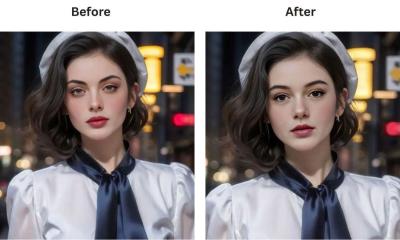“Don’t Worry Darling” has become a hot topic since its release, stirring conversations and sparking theories. Directed by Olivia Wilde, this psychological thriller blends mystery with a deep dive into societal norms, relationships, and the often blurry lines of reality. Set against a vintage aesthetic that exudes the charm of the 1950s, the film captivates audiences not just with its stunning visuals but also with its intriguing narrative. As we unravel the layers of this film, we discover that it’s not just about the plot; it’s a commentary on the roles we play in our lives and what happens when those roles become suffocating. Let’s dig deeper into the premise of this gripping thriller.
Overview of the Film's Premise

At its core, “Don’t Worry Darling” invites us into the seemingly idyllic world of a 1950s community called Victory. The film follows Alice Chambers, played by Florence Pugh, who is living what appears to be a perfect life alongside her charming husband, Jack (Harry Styles). However, beneath the glossy surface of this utopia lies a much darker reality.
As Alice begins to question her surroundings and the mysterious nature of Victory, she discovers that not everything is as it seems. Central themes include:
- Illusion vs. Reality: The film cleverly plays with the concept of perception, challenging the viewer to question what is real versus what is an illusion.
- Gender Roles: It critiques the traditional roles women are expected to inhabit, emphasizing the struggles of autonomy and self-discovery.
- Psycho-Social Manipulation: The narrative delves into how societal expectations can manipulate behavior, culminating in a sense of entrapment.
The film beautifully intertwines these themes, creating a rich tapestry filled with suspense and emotional depth. As Alice navigates her journey of self-realization and empowerment, audiences are left questioning the boundaries that separate conformity from freedom. Will she find a way to break free from the clutches of Victory, or will she remain trapped in an illusion? That is a thrilling mystery that keeps viewers guessing until the very end.
The Role of Rumbling in the Narrative
In “Don’t Worry Darling,” the concept of rumbling serves as a powerful narrative device that builds suspense, drives the plot, and foreshadows deeper emotional and psychological conflicts. The rumbling sound affects the characters and the audience alike, creating an atmosphere filled with tension and uncertainty. So, what exactly is the role of rumbling in the film? Let’s unpack this.
- Creating Suspense: The rumbling sound often echoes throughout scenes, drawing attention and amplifying the tension. Its ominous presence acts as a harbinger of impending chaos, urging the audience to lean into the mystery.
- Symbolizing Inner Turmoil: The persistent rumbling can be seen as a representation of the characters’ subconscious fears and unresolved issues. It reflects their internal struggles, mirroring the chaos in their perceived utopia.
- Foreshadowing Events: The recurrence of the rumbling noise hints at major plot twists and shifts to come. Each rumble transports viewers closer to the characters’ ultimate truths, keeping them on the edge of their seats.
As the narrative unfolds, the rumbling evolves from a background noise to a pivotal element, intertwining with the characters' journeys. It serves as a motif, connecting the dots between their realities and illusions, ultimately revealing the fragility of their world.
Character Analysis and Their Connections
“Don’t Worry Darling” introduces a host of complex characters, each with their own distinct motivations and emotional landscapes. Understanding their connections not only enriches the narrative but also deepens our appreciation for the underlying themes of control, freedom, and identity.
| Character | Role | Significance |
|---|---|---|
| Alice | Protagonist | The embodiment of curiosity and rebellion. Alice's journey represents the quest for truth. |
| Jack | Alice's Husband | A symbol of patriarchal control, Jack's character illustrates the costs of conformity. |
| Margaret | Friend | Her fate serves as a crucial turning point, hinting at the dark secrets of their world. |
As these characters interact, we see a web of relationships that reveal vulnerabilities, aspirations, and tensions. The connections between them often mirror the rumbling motif, underscoring the film’s central premise: the struggle for authenticity in a manufactured reality. Each relationship is filled with layers, prompting viewers to question trust, love, and the boundaries of personal autonomy.
Thematic Elements Explored Through Rumbling
In “Don’t Worry Darling,” the rumbling serves as a powerful narrative device, encapsulating the film’s various thematic elements. It’s not just a sound; it’s a manifestation of the underlying tensions and conflicts that drive the story forward. Below, we unpack some of the prominent themes that the rumbling encapsulates.
- The Nature of Reality: The rumbling symbolizes the characters' struggle to discern reality from illusion. As the plot unfolds, the incessant noise mirrors their internal chaos, prompting viewers to question the validity of their world.
- Control vs. Freedom: The rumbling juxtaposes the controlled environment of the utopian setting against the desire for personal freedom. It serves as a reminder of the lurking dangers of manipulation and the quest for autonomy.
- The Impact of Deception: The rumbling creates an atmosphere of unease, emphasizing the theme of deception that permeates the storyline. It highlights how layers of lies can collapse under their weight, leading to chaos and conflict.
- Gender Roles and Expectations: The rumbling echoes the pressures faced by the characters, especially the women in the film. It reflects societal expectations, illustrating the emotional turmoil of trying to adhere to traditional roles.
- Collective Consciousness: Lastly, the rumbling can be seen as a representation of the collective unconscious—a shared feeling of discontent among the characters. It brings to light issues of mental health and the burden of societal demands.
Through these themes, the rumbling in “Don’t Worry Darling” acts as a critical narrative tool, weaving together the characters’ experiences, struggles, and desires into a cohesive tapestry.
Conclusion and Final Thoughts
“Don’t Worry Darling” brilliantly fuses suspense with psychological depth through the pervasive rumbling that echoes throughout the film. As we’ve explored, this sound isn’t just a backdrop; it’s a pivotal element that underscores the complex themes woven into the narrative.
In concluding our exploration, we can appreciate how the film challenges us to confront our own realities and question the boundaries of our perceptions:
| Key Takeaways | Reflections |
|---|---|
| The rumbling serves as a symbol of internal conflict. | What internal struggles resonate with your own life? |
| It highlights the dangers of manipulation. | How do you challenge deception in your relationships? |
| The film explores gender roles and expectations. | What does gender parity mean in today’s society? |
Ultimately, “Don’t Worry Darling” invites audiences to dive deeper into its layered narrative. It encourages us to reflect on our own lives, the roles we play, and the realities we shape. So, the next time you hear that rumbling, consider what deeper truths it might be revealing. After all, in this beautifully complex world, sometimes what we’re meant to fear is the very truth we seek to uncover.
 admin
admin








